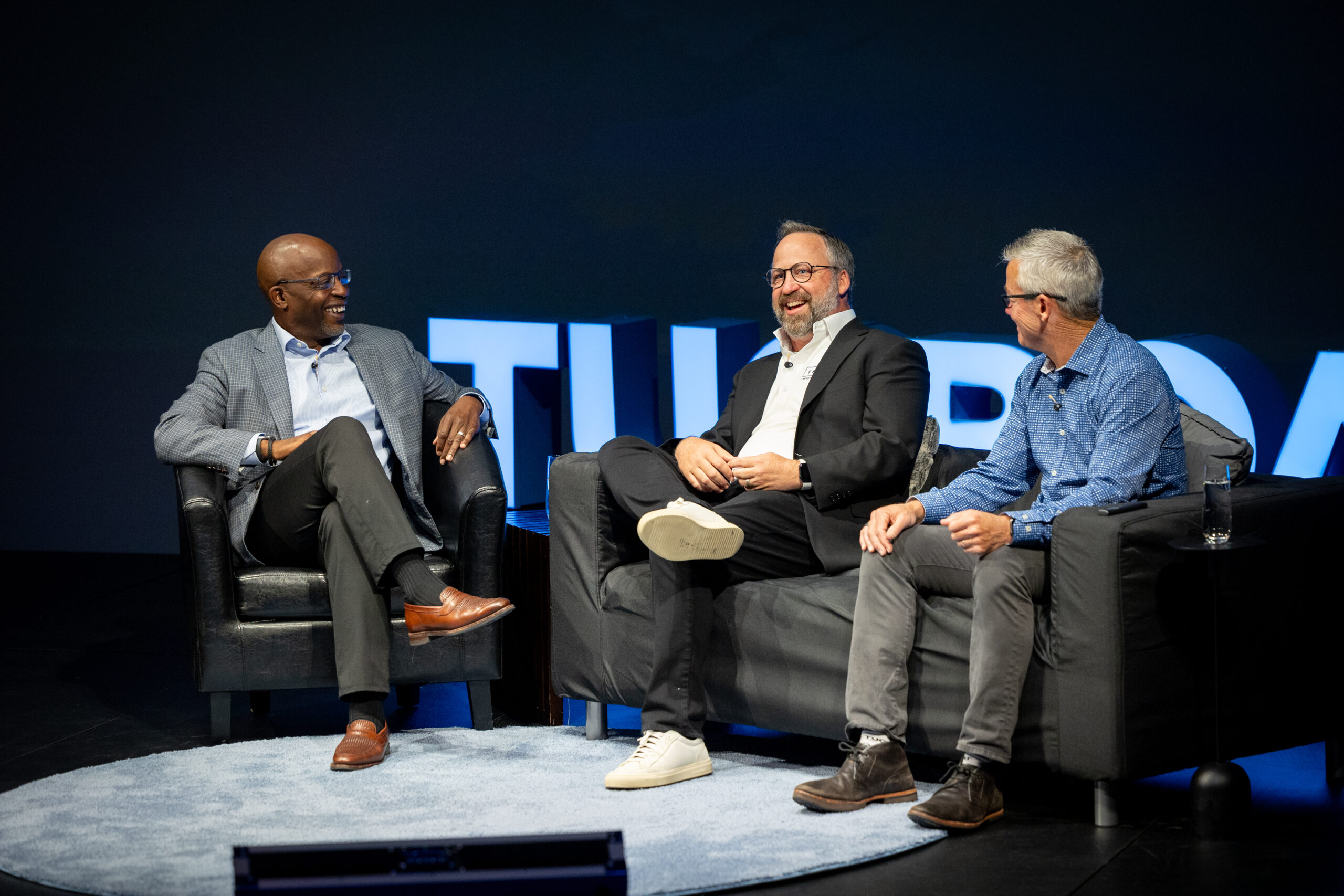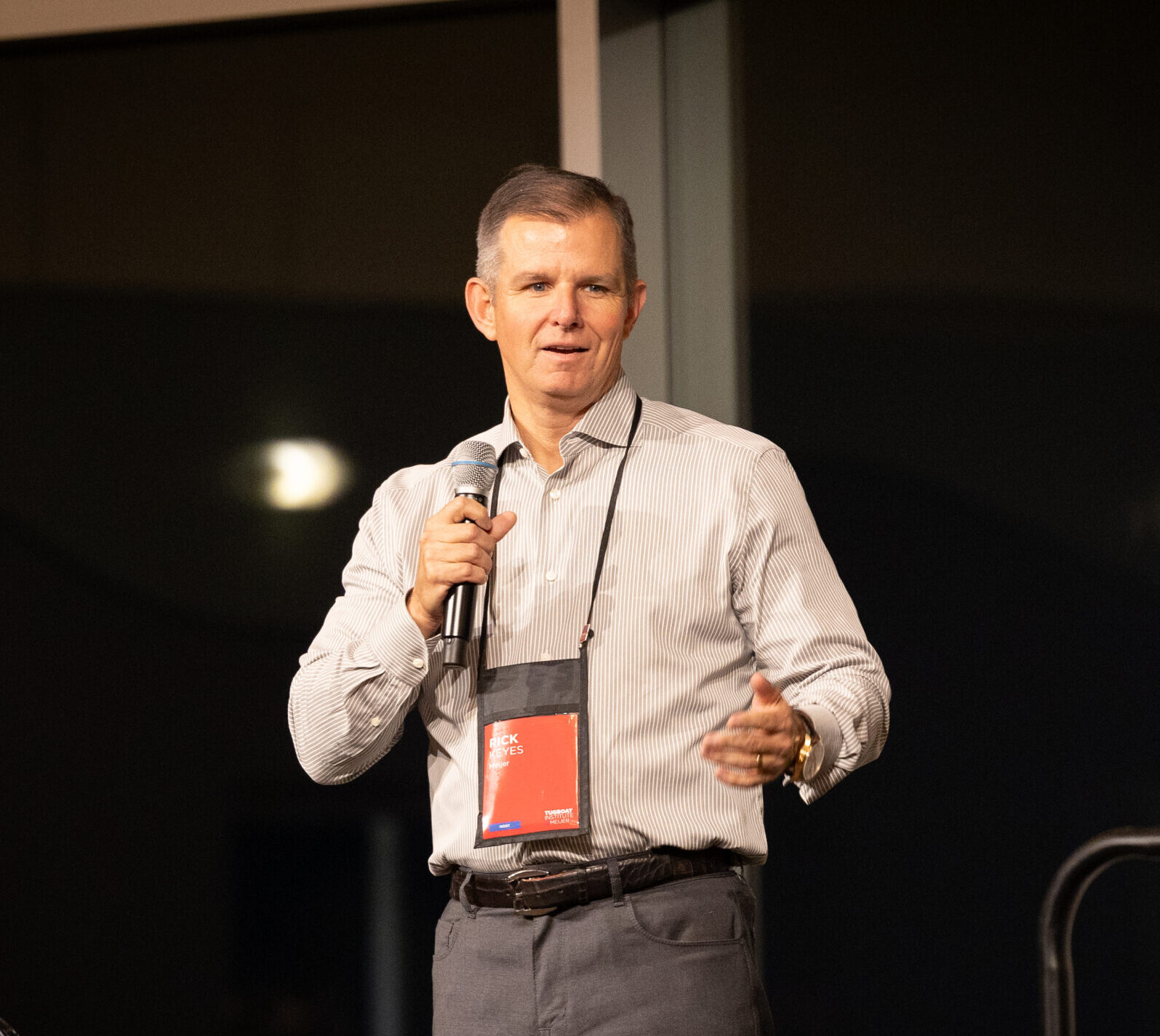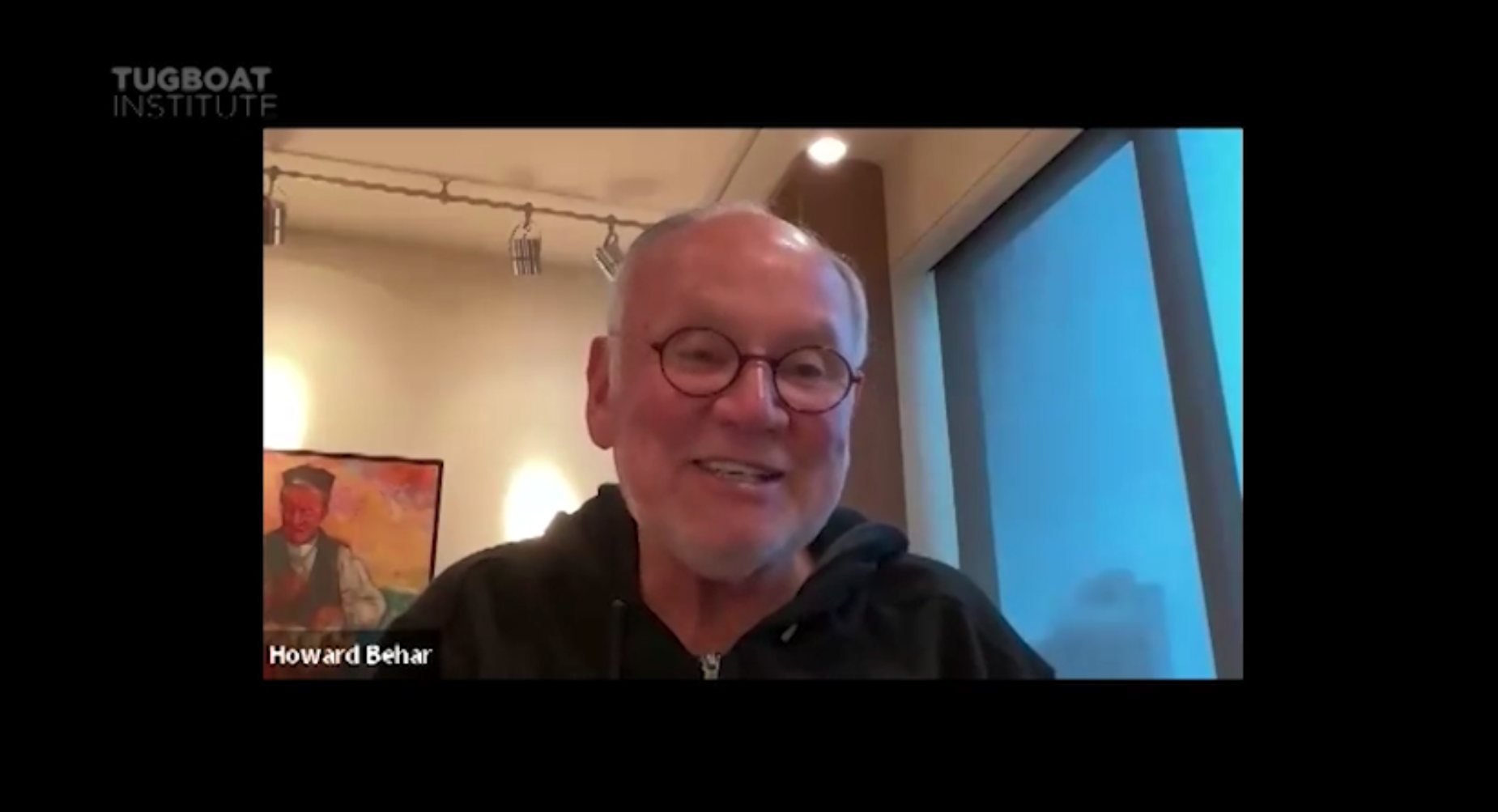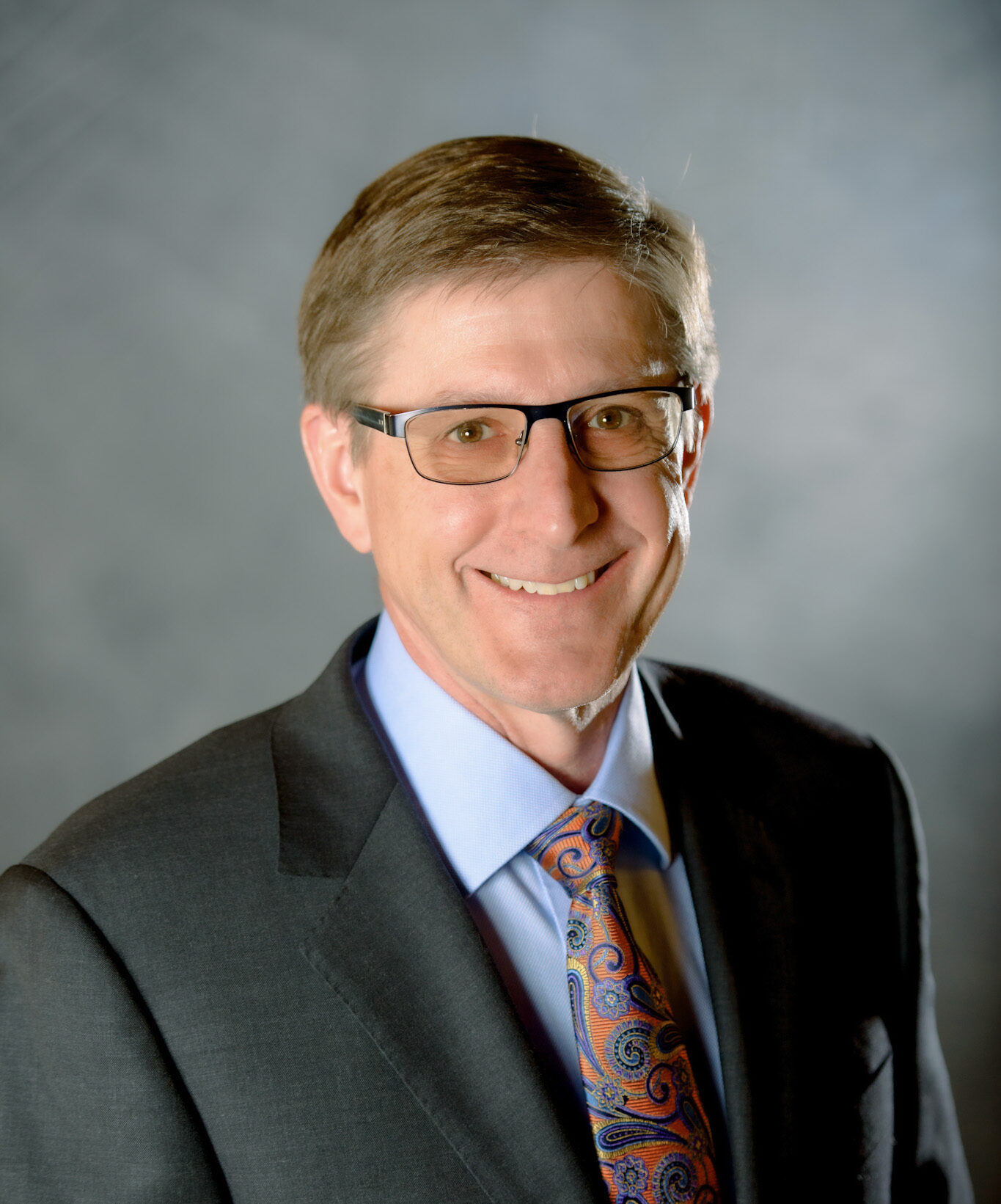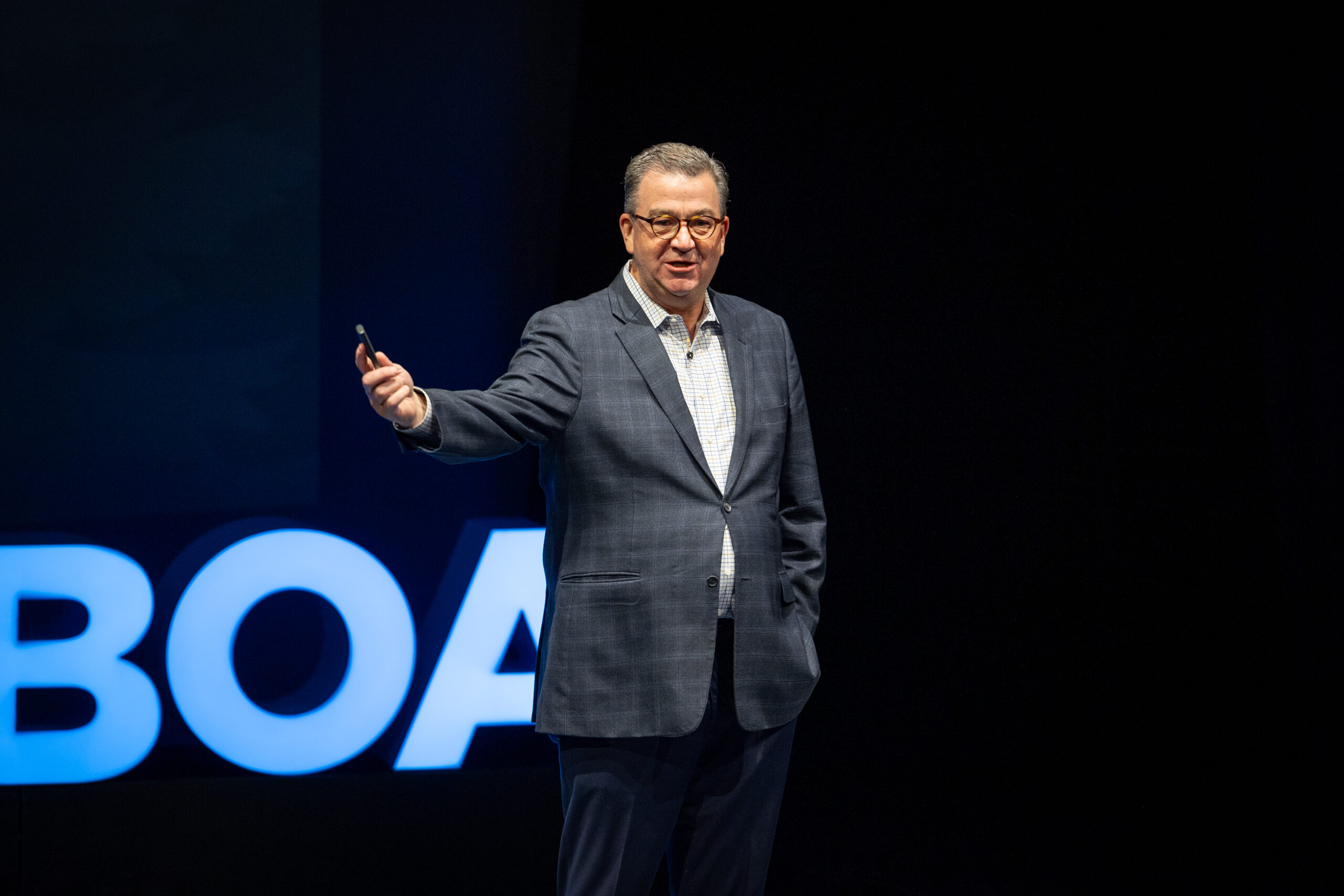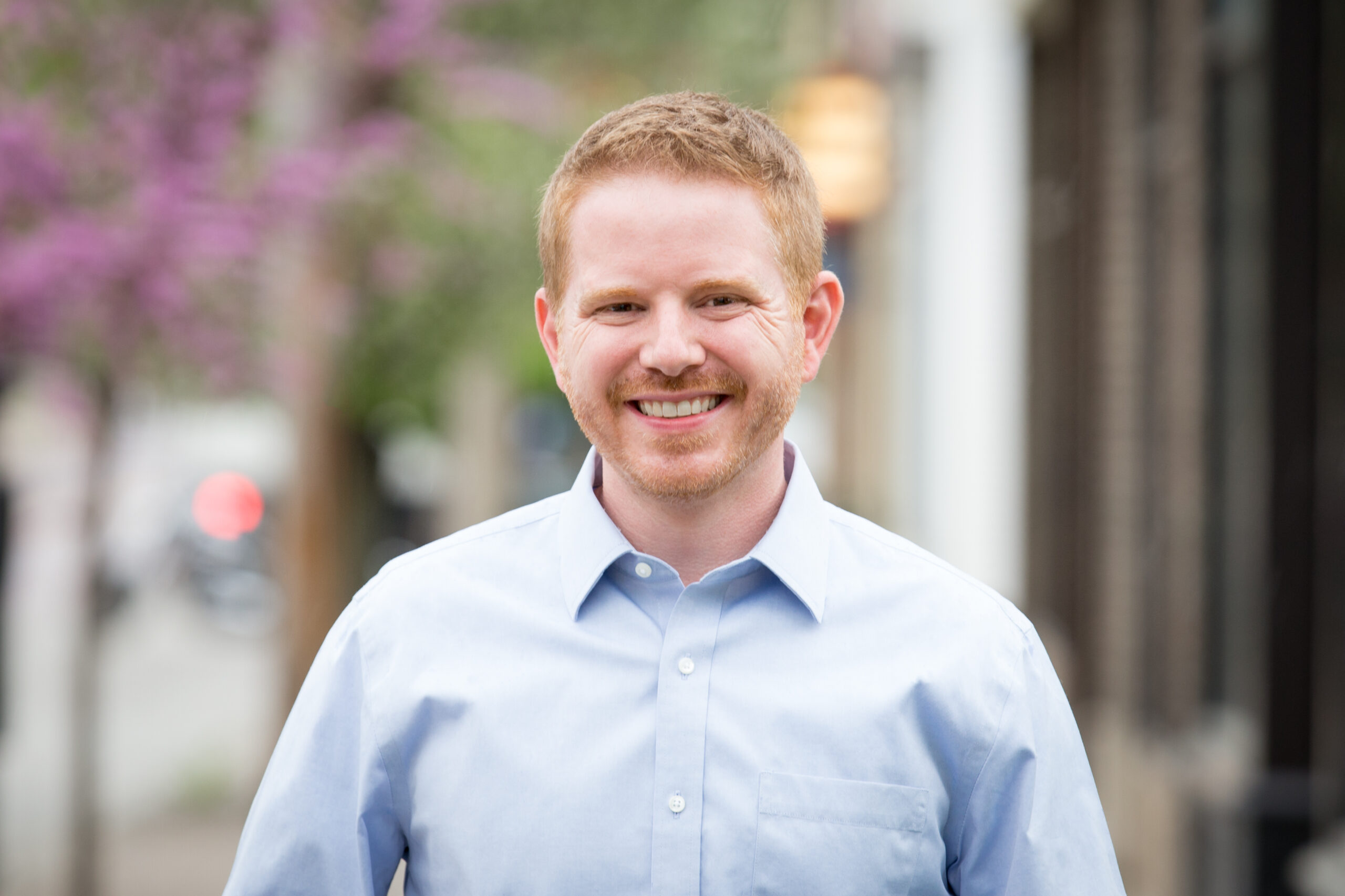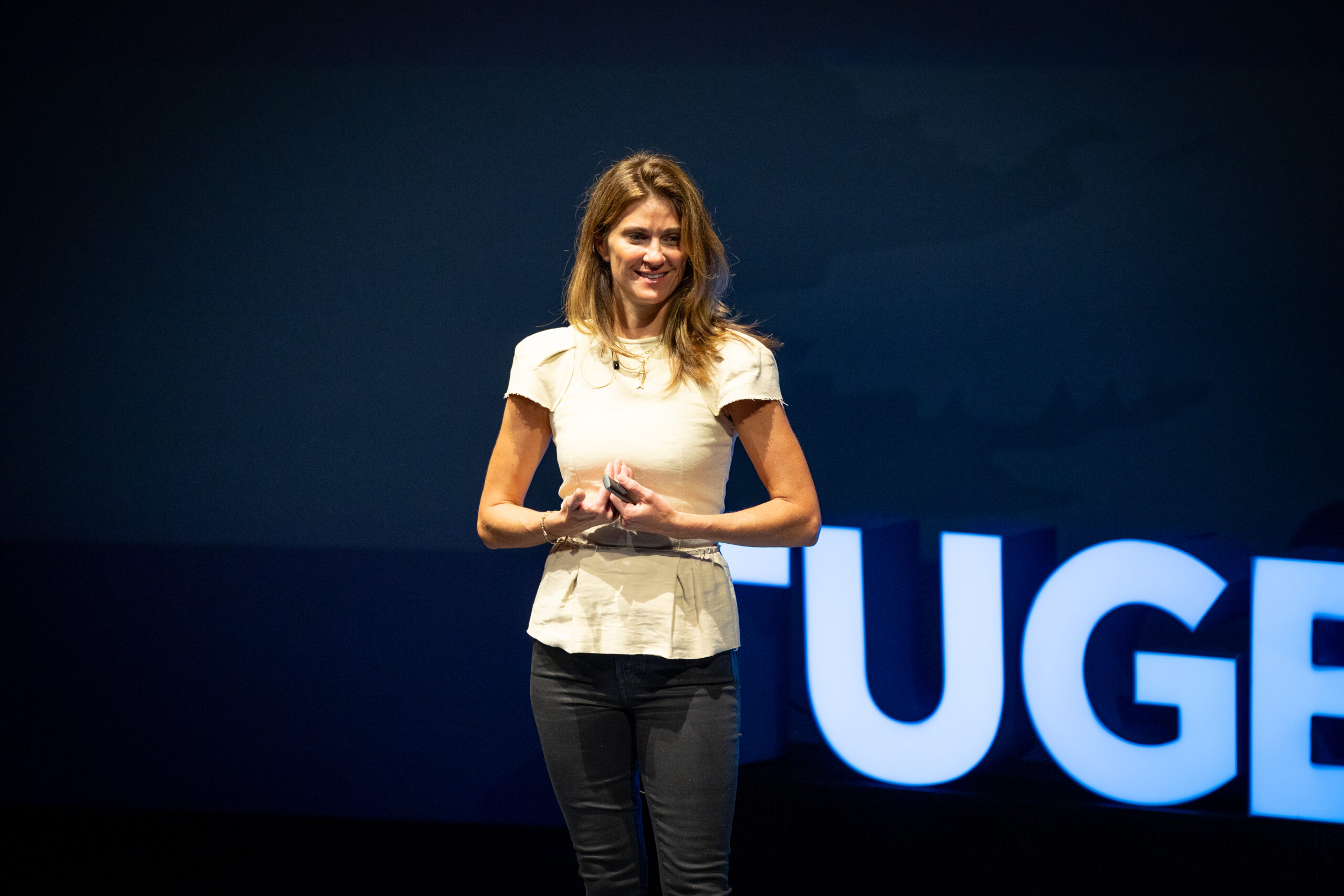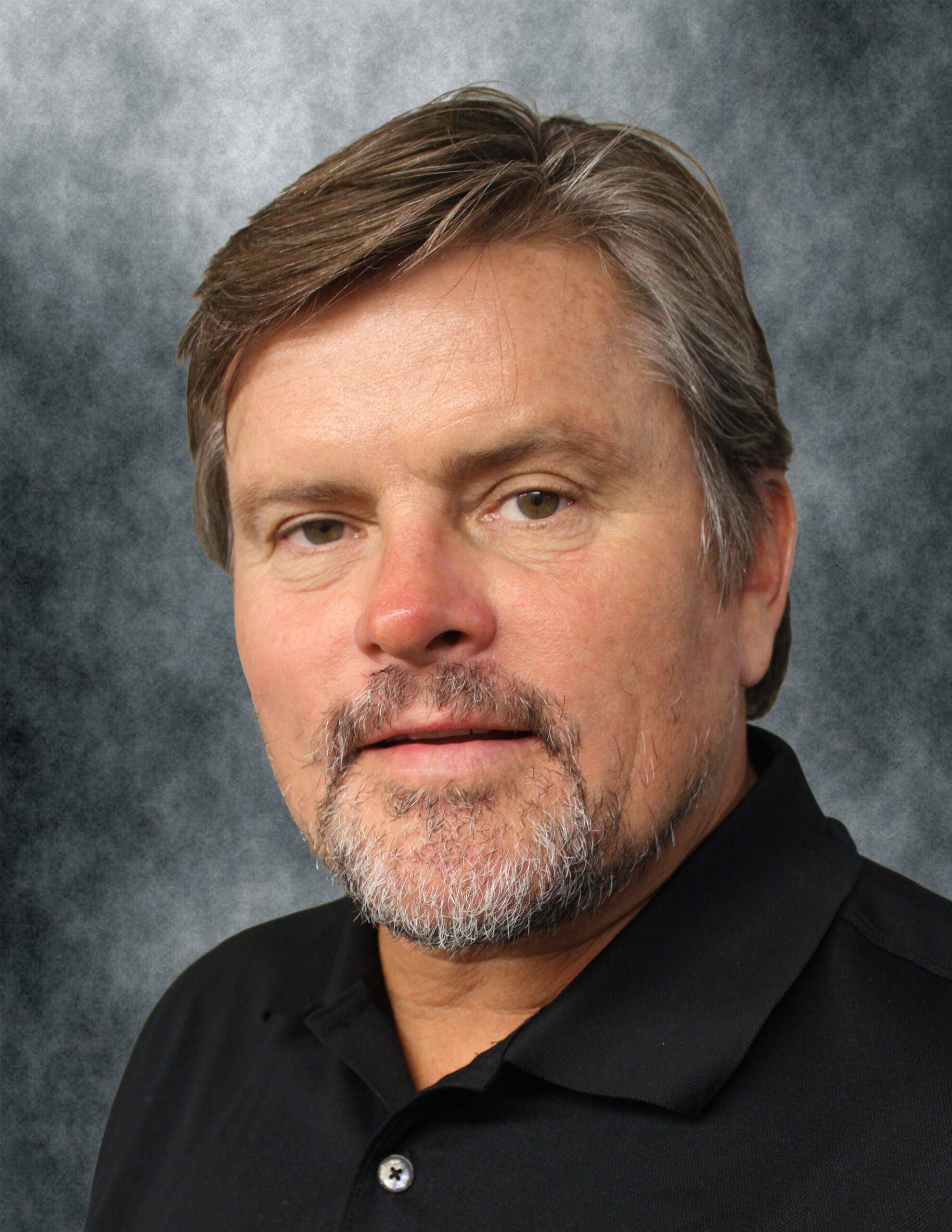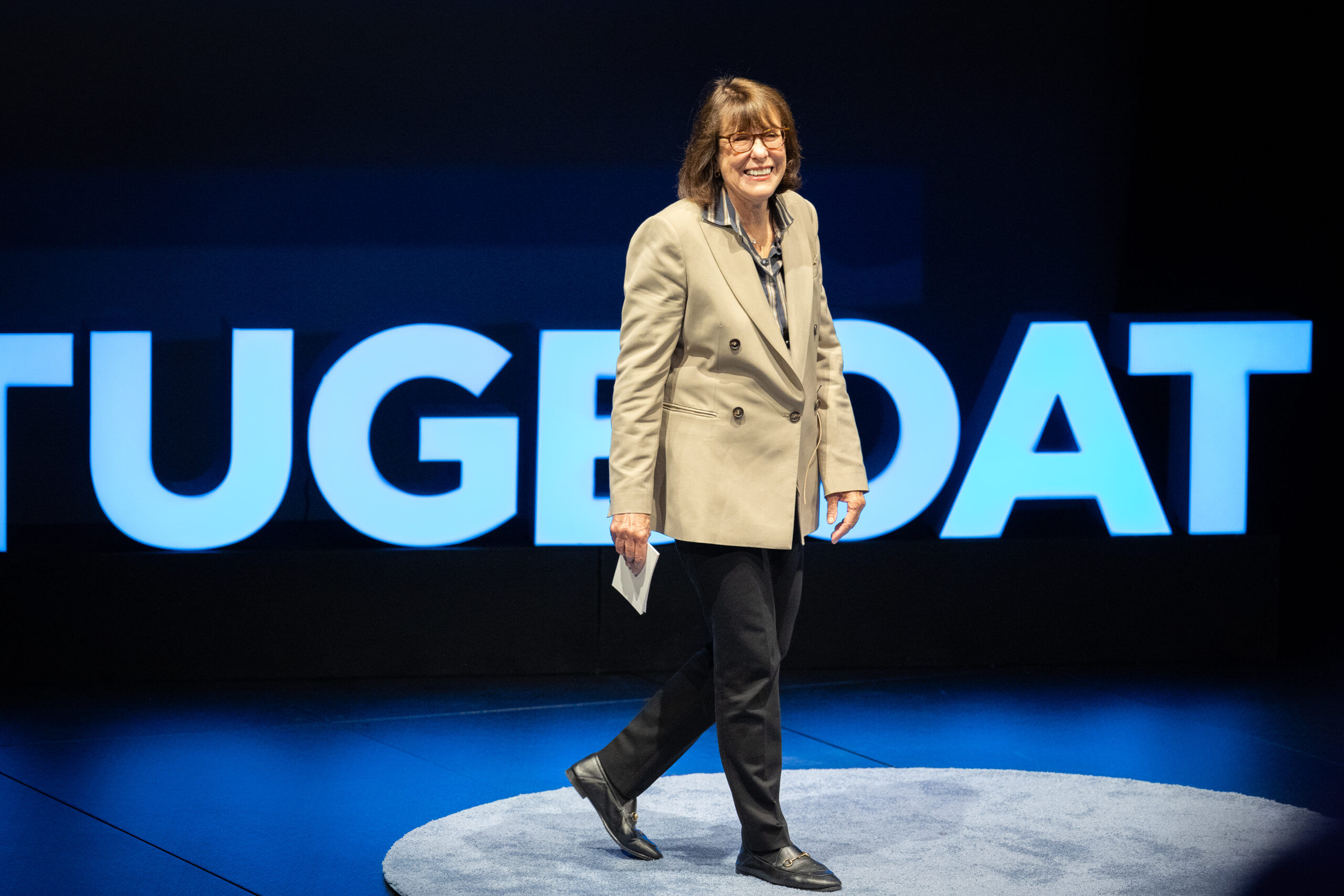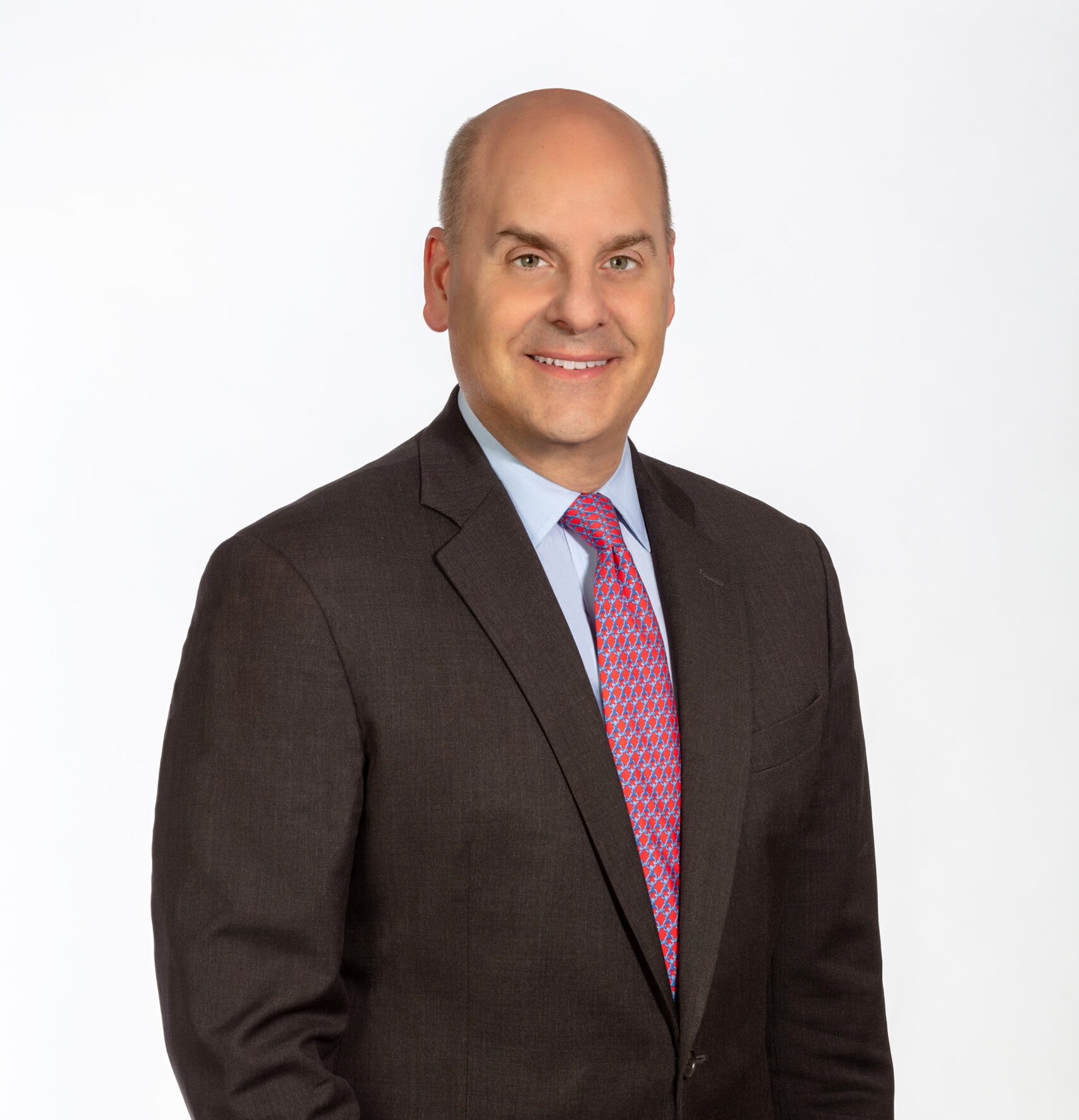Closing the Gap: Taking Action in Our Spheres of Influence
At Tugboat Institute® Summit 2023, Tugboat members John Gavan and John Garrett joined Mel Gravely on the stage to share the learnings and actions they have taken themselves in the two years since Mel’s first Tugboat Institute talk, What We Can Do Together About Race?
Instead of being directive about what any of us should or should not be doing to help close the rights gap by race, John and John each offered examples of what their first steps were and what progress they have made, in both the personal and professional spheres, on this important topic. John Gavan has directed his efforts through LeaderFlow, an industry-based organization he co-founded to support upcoming, diverse leaders in the field of architecture, engineering, and construction. John Garrett’s efforts started on a more personal level and have led to realizations and new understandings that have and will continue to inform the way he runs his business.
Mel deftly moderates this discussion, which not only offers ideas and inspiration to business leaders looking to learn and to take their first steps, but which also stands as proof that courageous and respectful conversations are possible.
Tugboat Institute @Meijer: Persist with Purpose and Create Something Extraordinary
While not well known outside of the Midwest, Meijer is a remarkable Evergreen® company founded by Hendrick Meijer and his son Fred Meijer 90 years ago. If the Meijer family wasn’t so humble, many more would know about it beyond the states in which it operates and in which Hendrick and Fred introduced the one-shop-stop superstore concept in 1962.
The purpose of Meijer is “Enriching Lives in the Communities We Serve.” Last week at Tugboat Institute® @Meijer, Tugboat Institute members were able to see how this Purpose comes to life. CEO Rick Keyes and his outstanding executive team welcomed us to Grand Rapids and inspired us to keep believing in the power of the Evergreen company to grow from modest beginnings and make a staggeringly positive impact on its employees, customers, suppliers, and communities over decades. We were treated to three inspiring and interesting days of learning, connection, and celebration.
In 1934, Dutch immigrant Hendrick Meijer opened the first Meijer grocery store as a way to utilize a building he owned for his barbershop. He passed leadership to his son Fred, who started in the business at the age of 10, and who grew the business into one of the largest and most influential companies in the country.
Rick Keyes is the CEO of Meijer and works with the 3rd generation of Meijer stewards, who serve on the board and remain committed to Meijer’s values and growth. Rick started working at the company 34 years ago as a pharmacist in a store in Columbus, OH, and he quickly fell in love with the complex, energetic, and fast-paced model of the superstore. He moved rapidly into leadership, first in the pharmacy division, and then store management, at the age of 24. He served the company in many leadership roles over the years and was named CEO in 2017.
Under Rick’s leadership, which is characterized by humility, commitment to excellence and the founding values, and a profound desire to perpetuate Meijer’s positive impact in its communities, the company has continued to grow and thrive. Among other notable accomplishments as CEO, Rick has moved the company from a pattern of growth in fits and starts to a more regular cadence of growth, through which they aim to open 5-7 new stores per year, while refreshing every store once a decade.
As is our custom when Tugboat peers gather, we began our week with a celebration. Reconnecting with old friends and to discovering new ones always sets the stage for an energetic and inspiring week. We spent the next few days hearing from Rick, his executive team, Hank Meijer, and Mark Meijer at the impressive Fred Meijer Corporate Office in Grand Rapids. They covered topics ranging from the history of the company, the role of the family in the company today, the many ways Meijer takes care of its team, new innovations in the works in marketing and store experience design, supplier inclusion, pragmatic innovation, and more. We were all struck by the collective generosity and trust that characterizes Tugboat membership as Rick, his team, and the Meijer brothers candidly offered a deep look into the structures and processes that drive their impressive company, as well as the challenges they have faced over the years. Then we had the opportunity to visit one of Meijer’s superstores and see for ourselves how deeply aligned and cohesive the whole team – from executive leadership to store directors to cashiers – is across the organization. The level of excellence, care, and positivity that Rick and his team presented are abundantly evident in every aspect of the stores themselves.
In the evenings, we spent time celebrating in downtown Grand Rapids, and we also had the opportunity to visit the Frederik Meijer Gardens & Sculpture Park, which stands as the embodiment of the Meijer family’s deep care for and commitment to their community. Fred Meijer had been collecting and warehousing sculptures and when the idea of creating a botanical garden was raised by a local non-profit, they took the opportunity to create something unique for their Grand Rapids community. In addition to beautiful greenhouses attached to the main building which hosts a museum on the site, the 158-acre botanical gardens are home to one of the world’s most important collections of outdoor sculptures, including pieces from Fred and Lena’s personal collection, pieces on loan from other collections, and pieces commissioned for the gardens themselves.
Longtime company and family leader Fred Meijer often repeated his aim to “leave the world in a little better shape than when I entered it.” After our week together in Grand Rapids, we can say with confidence that Fred would be astounded by the extent to which his vision is being fulfilled today. Rick, Meijer family leaders, and the entire Meijer team stand as exemplars of the extent to which an Evergreen company can, if it persists and stay focused on its Purpose and the other Evergreen 7Ps® principles, make a dent in the universe.
Two Jims
Howard Behar joined Starbucks as President of North America in the very early days of the company. He learned quickly that as a leader, CEO Howard Schultz truly cared for the company’s people, from its employees to its customers.
In this Tugboat Institute® talk, Howard shares the stories of two men named Jim, a Starbucks customer and an employee. The stories illustrate what “caring like you mean it” looks like, and how far Howard Schultz was willing to go for his people.
Watch and be inspired to care like you mean it.
Building a Structure for Family Governance in Advance of a Generational Shift
I am the third-generation leader of Burger Specialty Foods, with origins going back over 95 years. I wrote an article for Tugboat Institute®’s Evergreen Journal in 2019, where I shared initiatives that our Family Council had undertaken since it was established in the early 1990’s. Our renewed effort to strengthen family/owner governance structures is based on the understanding that, in a multi-generational family business with an ever-expanding family like ours, policies and guidelines need to be carefully thought through and established – not once, but periodically in order to keep them relevant over time. At the time, my objectives were to preserve family harmony, provide a meaningful way for future family members who did not work in the business to become involved, and ensure that a structure was in place that would be effective and efficient in governing all areas of family involvement. Now, four years later, as I plan to pass the CEO torch in a little over a year, my objectives remain the same, but our focus has shifted.
For background, in 2019 the Family Council launched the Family Board consisting of six non-working family members representing each major family branch because the Family Council, representing all direct descendants, their spouses, and children over the age of 14 (totaling 45 people at last count), had gotten too big to be an effective decision-making body. The Family Board has accomplished a lot. It serves as a great forum to inform and educate. They updated our family entry guidelines, are currently working on family exit guidelines, and will be working on a Family Purpose Statement with the help of Peter Boumgarden, a professor at the WashU Olin School of Business. They also organize and set the agenda for the annual Family Council meeting, our biggest, collective family celebration each year. In the future, the Family Board may assemble a Family Constitution to keep track of our governing documents.
Today, Burger Specialty Foods is owned by 18 G2 and G3 family members. The second generation are all retired and most are in their 80’s while many in the third generation, like me, are approaching retirement age. Six members of the fourth generation out of 18 are working in the business. We are blessed with a family that is burgeoning and thriving, so we need to continue planning for all facets of management and owner transition. My successor has been named, and I feel great about that, but owner transition is also critical, and we need to develop a plan.
Determining the rules for G3 ownership eligibility was a lengthy, and quite frankly, grueling family negotiation in the late 1980’s, but we hammered out an agreement, lived by it, and benefitted from decades of tranquility as a result. Now we need to make sure the next owner transition can prove the test of time. It’s a different dynamic today because the size of the family has grown exponentially, which has changed our perspective on some of the guidelines we established for previous generations, such as allowing married-ins to own stock. In order to minimize owner complexity, at least to some extent, the Stockholders voted to limit ownership to the lineal descendants of the first generation beginning in the fourth generation.
In addition, the Stockholders established an Owner Council, composed of six G3 owners, one from each family branch, to grapple with how to transition voting control past the third generation. Our Stock Restriction Agreement allows non-voting shares, representing 80% of the issued stock, to transfer unobstructed to the lineal descendants of the owner. The agreement stipulates that the Company has the right to purchase the remaining 20% of voting shares any time they are offered. The Owner Council mandate is to develop a plan for the transfer of voting control to the next generation and report back to the Stockholders. Should working family retain 100% control? Should the non-working group have the option to own a minority block of voting shares? If so, how much? This is a work-in-process.
I am fortunate that the Management Team is very capable of running the business and that has allowed me to focus on building rigor around our Board of Directors, Family Board, and our newly formed Owner Council. It’s best to develop policies proactively rather than waiting until you have a problem to solve “with a name on it.” It’s important to make sure you get the right decision-makers in the right room, to borrow from Josh Baron’s Four-Room Model.
I’ve heard that family governance in a multi-generational family business is the last of the major governance structures to emerge. That may be true, but as we continue the shift from G3 to G4 and beyond, we recognize that no matter when you start the process, your governance structures and the policies and guidelines they create will need to be revisited and revised at least every generation to make sure it still works for the present and future family, not the one you see in the rear-view mirror. The value in creating and codifying a Family Purpose Statement, as well as in clarifying policies and guidelines, serves as a road map for the future and will help ensure that the spirit and wishes of the family shape the decisions made by the owners, board, and management team.
What Business Are You Really In?
James H. Gilmore is the co-Founder of Strategic Horizons, LLC, a thinking group that helps businesses imagine and design new ways to add value to their economic offerings. In 1999, he co-authored the book The Experience Economy with Joseph Pine II. In it, they introduced their groundbreaking framework for understanding the progression of economic value over the course of modern human history. They proposed that each time the defining motor of an economic era shifts, it takes us some time to understand and realize that we are no longer primarily selling our customers what we think we are selling them. In 1999, they proposed that we had progressed from a service economy to an experience economy. Now, Jim tells us, it has shifted again.
In this Tugboat Institute® talk, Jim expounds on his original theory. He then shares his updated thinking on the model. He proposes that today, most of us have caught up with the reality that what we've been primarily selling in recent decades is an experience, rather than a good or a service. However, we are lagging again. According to his model, while we may not yet realize it, the focus of our businesses has again shifted; we are now in a transformation economy.
Watch and understand what this might look like in your industry and company, and how you need to adjust your strategy to keep current.
Lessons in Growth and Humility: Atomic Object’s Failed Expansion
In 2011 as we celebrated Atomic Object's 10-year anniversary, the question of our next strategic move loomed large. With a strong culture and thriving team, we wanted to share Atomic with more clients and practitioners than those in our home base of Grand Rapids, MI. This is where our journey into opening a second office–and eventually deciding to close it–began.
Atomic Object is a custom software and design development firm. Our first CEO, Carl Erickson, founded the company in 2001 and shortly thereafter, I joined the consultancy as its first software developer. In 2019, Carl passed the baton to me and Atomic’s other co-CEO, Shawn Crowley, but in 2011, I was still relatively new to leadership. Nevertheless, Carl gave me and Shawn the opportunity to drive the implementation of our next strategic move; it was an early test for us.
Our first ten years of offering our services in Grand Rapids demonstrated a real market fit, and we wanted to share what we’d learned about crafting reliable and beautiful software with more people. As an Evergreen® company, we favor Paced Growth over explosive growth. This made us a bit of an odd duck in the software space. We liked the idea of being excellent instead of big, and we saw growth as a side effect of our quality, rather than an end in itself. We considered a few different ways of sharing more Atomic with the world: creating our own product, diversifying our offering, or perhaps venturing into a new city. The challenge lay in finding a way to evolve while preserving our culture.
Part of Atomic’s culture is working in pairs. The agile concept of pair programming in software development extends into other ways of working. I am co-CEO, for example, and I find that working with my counterpart Shawn improves the way each of us manages and leads. Wherever Atomic employs pairing, trust and communication flourish, and we make all major business decisions with at least one other person. This isn’t always the most efficient way to run a company, but I believe it’s a great practice for making enduring decisions that serve us long-term.
As we honed in on the idea of setting up a second office in a new market, we thought hard about our long-term future. Early in our history, Carl set a goal for Atomic to reach its 100th birthday. This encourages us to examine all of our major decisions using a long-term perspective. As we grew, we knew we needed to keep a careful eye on avoiding decisions that would cause us to stray from the core of who we are.
We crafted a plan and identified Detroit as the new Atomic location. Detroit was undergoing a revival, and we saw the opportunity to be part of the city's resurgence. The city's proximity to Grand Rapids made logistical sense, and the idea of contributing to Michigan's economic prosperity resonated with us.
Our excitement soon met reality.
One early challenge we found was attracting senior talent to our new downtown location in the sprawling city; senior talent preferred living and working in the suburbs rather than commuting downtown. This made establishing strong office leadership a challenge. If we were able to find one good person for a given position, we could rarely find two, which compromised the Atomic pair structure.
From a client perspective, we were finding more success winning work from massive companies. This strained our historical product-centric approach that allows us to serve a wide array of clients. Slowly, we realized we had allowed for a situation where the client’s culture risked supplanting our own. And of course, having so much business focused on so few clients exposed us to huge risk. Despite the hurdles, we continued on.
At this time, we were presented with the opportunity to acquire a struggling software consulting firm in nearby Ann Arbor. The allure of a new market and talent pool led us to seize this chance. We figured our early lessons from Detroit would help us avoid some of the pitfalls we were still encountering there. Over the next couple of years, the Ann Arbor office flourished while Detroit’s continued to struggle. In 2015, we made the difficult decision to close the Detroit office by consolidating its team into Ann Arbor’s.
When we took a step back, it was clear that our only option was closing the office; that didn’t mean it was easy to do in practice. When Carl, Shawn, and I discussed the coming closure, we had real fears: would our team lose trust in our decision making? Would the news media ridicule our about-face? Would the move tarnish our reputation in the business community?
In reality, none of these came to pass. We learned that concern over others’ perceptions played an outsized role in our predictions about the future. And anyway, we couldn’t let concern over potential ridicule prevent us from making the right choice for Atomic.
As time passed, this experience surfaced some competences we needed to develop if we were going to continue to grow thriving offices. To make our business work, our offices needed strong local balances of experienced and junior talent from which we can recruit. We also needed to mature in how we identified, onboarded, and trained leaders—whether that’s from outside the company or through promotions. And finally, we needed to learn how to measure the financial performance of an office. Our subsequent office expansions benefitted from these new competencies. Today, with four thriving offices, our co-CEO model and shared leadership approach deepen our commitment to responsible growth, while preserving the core that defines us.
As we celebrated Atomic Object's 22nd birthday, we had our experience closing the Detroit office to thank for teaching us how to grow in the right way. Our path to launching a second office took twice as long and cost more than we expected—and it was more than worth it.
Entrepreneurship Within the Family Business
In her native Kentucky, the bourbon created by Carrie Van Winkle Greener’s great-grandfather, Pappy Van Winkle, is legend. Carrie’s older brother stepped into the family business, the Old Rip Van Winkle Distillery, at the start of his career but Carrie and her two sisters, who are triplets, sought their own opportunities elsewhere. Until, that is, they perceived an opportunity to start a new business, and at the same time, enhance the family’s historic brand.
In this Tugboat Institute® talk, Carrie shares the story of Pappy Van Winkle and of the founding of her own company, Pappy & Company. As she and her sisters spun this company off the family brand, she learned powerful lessons about the importance of family harmony, clarity of brand identity, and entrepreneurship.
Watch and be inspired to see opportunities not just within, but also alongside of, your family business.
Pragmatic Innovation and Perseverance in Flyover Country
I live in the “other Minneapolis”- the one in Kansas. I am sure most of you never knew that there is a Minneapolis, Kansas, but there is. As an industrial master distributor and manufacturer of fasteners, being in the “Great American Desert” is sometimes more real than I would wish. With just 2,000 people in our town, at Huyett, we must innovate to find the talent to support our growth.
In 2019, we elected to significantly expand our e-commerce. I was doing some personal recruiting in support of this effort and noted in regional newspaper headlines that Cabela’s - the outdoor retailer - was laying off a significant number of people in Sidney, Nebraska, a town of 6,700 in the panhandle of the state, near Wyoming. I started reaching out to people from Cabela’s via LinkedIn. One such recruit asked me if I was going to the job fair. “What job fair?” I asked.
Two days later, I was standing in the gymnasium of a community center and for five hours I had a line of recruits 40 deep wanting to interview with me. I was blown away. I went back the following three weeks, and the local community college allowed me to use a meeting room to interview people. From that talent pool, I hired a Vice President of Marketing and Technology and a staff of merchants, data analysts, digital marketers, and support personnel. It has been a smashing success. Now our little company out here in flyover country has the talent to build a leading e-commerce experience for industrial distribution.
Because we now had so many team members from Sidney, we decided to open a regional headquarters there last year. Here again, another unexpected opportunity arose; a former JC Penney’s store, the building was being used for meetings and social events by the local American Legion Post, but the Post was losing members. We agreed to buy the building but allow the American Legion to lease the basement for $1.00 per year. Now with some twenty-five employees assigned to the site, with continued prospects for growth, we have helped the community recover some of the lost jobs from Cabela’s downsizing, we revitalized an important building in the downtown, and we have to some extent rescued an American Legion Post. Win-Win-Win.
As part of this journey, we benefited from the mistakes of others. We couldn’t help but pay attention to the factors that had contributed to their distress, and were careful to learn from them. Along the way I learned something besides the power of innovative thinking and the willingness to jump at unexpected opportunities; I learned the value of being Private.
In my interviews of some 200 personnel who had been laid off from the failed Cabela’s, I learned of the risks of a company managed by a revered individual, who through time, moved from pragmatist to patriarch and the entire firm mellowed. Cabela’s went public in 2004 and the focus shifted from long-term to short-term. Layers of management developed, and job titles were inflated to create false career paths not built on increasing levels of contribution, but to justify increases in pay. The dangers of letting ego drive leadership, of greed, and of the subsequent loss of control and culture when a company goes public were crystal clear to me. That is never going to happen at Huyett.
In terms of the ways the culture was eroded, I learned of large pay inequities between men and women. As these management layers increased, silos began to develop. Innovation with the goal of quick growth resulted in short-term success, but eventually the public ownership caught up and all attention shifted to quarterly, financial performance versus Pragmatic Innovation and Paced Growth. I looked carefully at the systems and the pay structures we had built within Huyett and took steps to ensure we were not at risk for any of these problems. Being private, we can stay focused on the long term, stay true to our values, treat (and pay) all of our employees fairly, and innovate with an eye to growth that might not be lightening fast, but that will keep us steadily marching forward.
It's funny how Pragmatic Innovation works. It is not just innovation; it is Pragmatic Innovation. In matters here, I am not sure if we were just lucky, but we followed our instinct. It seemed logical. It was pragmatic. I have learned that business strategy is sometimes common sense. But along with common sense you must take risks and invest effort.
Thank God I was standing there when these opportunities arose. Maybe I got lucky once, or even twice, but I was careful to digest and learn the lessons from this experience. Next time, when we get an opportunity like this, it will be more than simple good luck that allows us to step in and make a success where a failure once stood.
Keys to Building Resilience in Your Family, Your Business, and Yourself
Dr. Madeline Levine is co-Founder of Challenge Success and a leading psychologist who has focused a great deal of her work on the mental health and challenges of young people coming of age in our modern society. In particular, in her book The Price of Privilege, she addressed a group that has been largely dismissed as being ‘fine,’ but that is not, in fact, free from challenges: the children of wealthy families.
In this Tugboat Institute® talk, Dr. Levine focuses on a skill that we all now accept as critical to survival in the modern world: resilience. As parents of children and as leaders of organizations, what can we do to foster this all-important skill in those we care about?
Watch and gain confidence as you strive to support and inspire resilience in your children, your employees, and yourself.
The Power of Collaboration: Create Value for Your Business, Your Industry, and Your Community
I run a company – Decipher Investigative Intelligence – that has 26 employees. We work in homeland security and in financial services, but the vast majority of our clients are law firms. We provide data, such as pre-hire due diligence, that helps clients grow more purposefully and profitably. In light of our small size, you might be surprised to learn that we have an established partnership with Thomson Reuters (TR), one of the world’s leading providers of news and information-based tools to a wide variety of businesses. They have over 25,000 employees and are traded on the New York Stock Exchange. The details of why they wanted to partner with us despite our small size are clear, but more interesting are the multiple benefits that this partnership has created – for Decipher, for TR, and for our professional community.
Because of the nature of our business, we have built a store of an enormous amount of data, and data of a very specific and unique nature. When a law firm or a company is preparing to make an offer to their next partner, board member, CEO, CFO, or General Counsel, they come to us to ensure they know everything they need to know about the person they are about to bring on board. We verify the information the candidate has reported, which, in the legal profession, is exhaustive, and we also look for anything that might not have come to the surface. It's our job to crawl around, underneath, over, and in between the words and figure out what kind of person they are. Someone can disclose everything that you’ve asked them, but that's not going to tell you whether they scream and yell at people in the office or do awful things to people after hours. Once we have gathered the information, which we have been doing for eight years now, we find ourselves with what turns out to be a very unique data set.
Thomson Reuters is massive by comparison, but some of their work intersects with ours. They have a branch called Thomson Reuters Legal, which does work in the legal space that is similar in some limited respects to what we do. In comparison with Thomson Reuters Global, the legal branch is relatively small, though still far larger than Decipher. They also have a branch called Thomson Reuters Institute (TRI), which is the arm of their business that mobilizes its own data set to advise its clients. We know many of the folks at TRI, and in particular, the director of advisory services, Brent Turner, has long been a friend of mine. He has watched me found and grow Decipher, and a few years ago, he and I started to see the potential for a powerful collaboration.
When we considered the dataset we had compiled at Decipher and the one they had compiled at TR Legal, we saw how powerful they would be together. We came up with the idea that we would take our collective data and put on a one-hour quarterly briefing for the market on talent trends and activity in the legal profession. TR primarily sticks to the financials, and we primarily stick to talent, so we divide the briefing that way. Brent brings to the table data on things like worked hours, worked recovered hours, billable hours, rates, demand growth, demand decline, etc., and we bring data on the actual people that are doing the work. We mesh it all together on a quarterly basis and we give it away in an hour-long briefing. Who tunes in? It’s the C-Suite: General Counsel, Managing Partners, and other senior executives. They tune in to learn about what’s going on in the market. It is extremely niche.
This answers the question about why TR would be interested in our very unique data set, which complements theirs so well. But it raises another – what value does this collaboration provide to TR and to Decipher? As I mentioned, we offer this briefing at no cost at all to the viewers. It’s clear that our information has enormous value to the industry, but if we have not monetized this service, how exactly does it add value to our respective companies? There are three main reasons why we feel this is worth our collective investment.
The first is a symptom of our Evergreen® mindset. We aim to be of service to our community and Purpose-led. It’s true that it is a good marketing tool and gets our name out there, but it's also a ridiculous amount of work. To embark on something like this, first and foremost, you have to want to help your friends and colleagues out, whether they're customers or not. Brent and I share this perspective and we are thrilled to be able to offer something that is worth a great deal, even if it is to a select few in a specific industry.
Second, we have something that we do better than anyone else. As a result of the fact that we do this so well, we have created something of great value, and even a huge company like TR can see that. The pooling of our data analysis benefits both TR and Decipher, as it helps us round out our understanding, expertise, and ability to serve our clients as best we can. As you consider potential partnerships or initiatives that might allow you to be of service and add value to your company and your industry, ask yourself what it is that your company does better than anyone else.
Third, in the words of Sy Syms, pioneer of off-price retail in the 1970s and 1980s, “an educated consumer is our best customer.” Whether they pay us for it or not, the better our customers and potential customers understand the industry landscape, the more meaningful the work we do. The single largest expense in any business is people. If you are running a business, you know that the failure rate of newly hired employees is extraordinarily high, even at the senior level, where they make a lot more money and have a lot more impact on the culture and value of the businesses they serve. Every time you can solve this problem – we call this the point of higher solutions ¬– and dodge one of those bullets, you are literally saving millions of dollars. The better our customers understand this, the more we can be of service to them, so it’s ultimately a win-win.
A partnership and an initiative like this might not be a fit for every company. But if you are Evergreen and Purpose-led, if you aim to be of service, if you have something you do better than anyone else, and if you want your customers to be educated, consider looking for opportunities that might allow you to accomplish all of those goals at one time.
